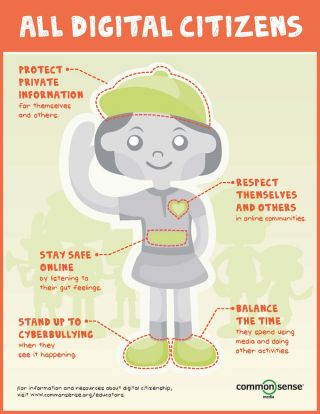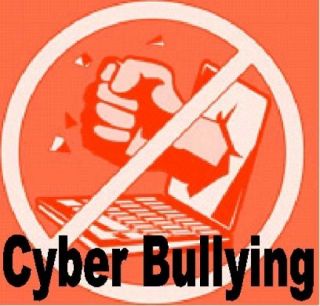Media
Promoting Digital Citizenship & Preventing Cyberbullying
10 tips for families & educators
Posted October 18, 2013
Digital citizenship week is upon us: October 21-25, 2013. For this week, I was asked by a colleague (a K-12 education professional) to write a blog post to help parents better engage with their children on these issues. Here are 10 suggestions for parents (and helpful for educators too!) to continue connecting with their children and supporting them as they learn to share aspects of themselves and interact with others online. I hope you find these useful!
1. Know your children’s digital worlds – There are so many new sites that youth are using that are often off of the radar of adults. Take the time to ask your children about what sites they enjoy using and then ask them about who are their contacts, and what do they like about those sites. Some of the more popular sites that aren’t as well known by parents and teachers but are widely used by adolescents include :
- ask.fm – an anonymous Q&A site that has been linked to at least 9 deaths due to cyberbullying. New users create any username they like and are invited to import their contacts via Facebook and/or Twitter. This site, developed by Latvian brothers and hosted in the Federated States of Micronesia (thus, the .fm), has 13+ as the age requirement. It was developed to be a rival to U.S.-based Formspring and has taken it over in terms of # of users. (more at CNN.com). A good friend described this site to me as 'toxic' and gave numerous examples of hateful, sexualized insults that were targeted at her child. Local educators have also told me about the problems they are seeing at schools as a result of this site.
- Spring.me (formerly Formspring)—an anonymous Q&A site also linked to numerous cases of cyberbullying. Similar to Ask.fm but due to declining popularity it was recently rebranded and relaunched.(more at Wikipedia.com)
- Snapchat – an image and text-based chat app that allows senders to set a time limit on how long the image will be available. Think “this image will self-destruct in 10 seconds” (more at CNN.com)
- Kik.com—an instant messenger app that can replace text plans by using the internet instead of SMS to send messages. Instead of phone numbers users create their own online usernames so people can be more anonymous if they choose. The legal age to use this app is 17+. More info for parents on Kik and internet safety and peer pressure.
- Chatroulette—this is a video chat program that allows users to randomly connect via video chat with anyone around the world. Studies have showed that approximately 1 in 8 feeds include “R-rated” content. A new program was developed to recognize inappropriate nudity and it is said to filter out 60% of “offensive material” and ads. http://en.wikipedia.org/wiki/Chatroulette
- Other popular sites that are more well-known include: Facebook, Twitter, Instagram, Pinterest, GooglePlus, MySpace, YouTube, and Tumblr (via Mashable)
- Vine & Pheed: are newly emerging social networking sites to look out for (via Policymic.com)
2. Engage with your children in and around these worlds—Show your kids you are interested. Try downloading these apps, participating in these worlds, ask questions about why the like them, observe their behaviors and interactions, ‘follow’ your kids and their friends, learn about the rules and norms guiding the practices in these sites.
3. Model and teach critical media literacy—Watch shows together and encourage them to ask questions, discuss media messages, evaluate if these social networks/ads/social norms are sources of harmful or helpful influences. There are some great resources to promote media literacy available at Healthy Media Choices and here. Media literacy week is coming up November 4-8, 2013.

4. Think carefully about how and why you restrict access—If you threaten to totally disconnect your child from their online worlds due to cyberbullying or other inappropriate behaviors, you risk preventing your child from confiding in you or sharing information about what is going on in their lives. Discuss potential consequences for these behaviors in advance so your child understands what they risk for inappropriate behavior, and how their online access may be limited (in hours, supervision, devices, apps) if they violate your agreements.
5. Don’t minimize the importance of online lives & the impacts of those relationships. This is a significant part of young people’s social worlds. Instead of passing notes, going to the mall, and talking on the phone for all hours as previous generations did, they hang out online. Many parents feel safer knowing that their children are home. However, if your kids spend many hours unsupervised online, they could be exploring social words that can expose them to predators and cyberbullies. Adolescents who seek external approval (most), and want to feel ‘popular’ (many), and appreciated for who they are (all) are particularly vulnerable. Respect your child’s experiences and listen carefully when they are ready to share. The more you include them in problem solving approaches, the more you can empower them and strengthen your relationship.
6. Monitor your child’s digital footprint—There are many tools available and supports via wireless providers, that enable parental monitoring. About 2/3 of parents say they to monitor their children’s online behaviors. In the spirit of openness and honesty, I would encourage parents to let them know you care and are involved. One grandmother agreed to get her 15 year old granddaughter a cell phone—but under the condition that the grandmother be allowed to fully monitor its use. You can read more about tools and approaches in these two articles from the NYTimes and Parenting.com
7. Model and promote open dialogue—Create spaces for open discussion about difficult issues. Many youth experience harassment online due to their body size, perceived sexual orientation, gender expression, race, disability, and dating/sexual history. If they can’t speak with you openly about these issues, there is a whole lot of their life you might not know about. There are some excellent resources available to spark healthy conversations on Commonsensemedia.org

8. Be aware of and respond to warning signs of cyberbullying— If your child starts to exhibit any of the following warning signs: persistent change in attitude or demeanor, avoiding school and peer groups, apathy, signs of depression or self-harm then you need to find out why. They may be reluctant to tell you for fear of losing privileges or may be ashamed of what is happening to them. If adults don’t provide immediate support to youth who are suffering, the long-term consequences are severe. If you don’t want to pry or intrude on your child’s privacy, think of the consequences –- would you rather be taking them to the hospital or attending their funeral? That’s blunt, I know, but you are the adult so you may need to step out of your comfort zone and be more assertive to find out what is going on.
9. Work in partnership with your child’s school— Inform teachers and administrators if there are issues they can help you address. If the cyberbullying or online interactions are having a negative impact on your child’s experience at school, they then the school has a duty to get involved. Impacts at school can include: chronic tardiness or absenteeism, drop in grades, quitting teams or clubs, increase in misbehavior or turning ‘invisible’ by being physically present but not engaging or interacting with anyone. In California, where I live, AB 746 went into effect January 1, 2012. This law revised the Education Code to address cyberbullying by allowing schools to suspend or expel students for “electronic” bullying which may include posts to social media sites. Previous case law indicates that schools can be held legally liable for not intervening when a student’s access to education has been limited due to cyberbullying.
10. Don’t hesitate to call the police if you suspect your child may be the target or perpetrator of illegal behavior: threats of violence, stalking, harassment, cyberbullying, and child pornography laws are all potentially relevant to extreme situations. More advice are available at webroot.com and CounselingCalifornia.com.
Resources
- for youth, families, & educators: http://www.commonsensemedia.org/digitalcitizenshipweek
- for teachers: http://www.edutopia.org/blog/digital-citizenship-resources-matt-davis
Related Blogs on cyberbullying:
- Michelle Borba - Parenting Expert
- Sue Scheff - Parent Advocate
- Rachel Simmons - Girls' empowerment expert
Other blog entries on Psychology Today by this author:




